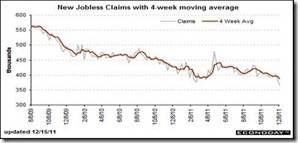Popular Economics Weekly
Consumers are spending for the holidays. Retail sales in particular have rebounded to almost pre-recession levels. Overall retail sales in November grew 0.2 percent, following a 0.6 percent boost in October (originally up 0.5 percent) and a 1.3 percent spike in September (previously up 1.1 percent). Retail sales in November rose 6.7 percent annually, compared to 7.5 percent in October. Excluding motor vehicles, sales were up 6.6 percent on a year-on-year basis, compared to 7.5 percent the month before.
Graph: Inside Debt
So once again, as with jobs, the numbers were higher than initially reported. Overall components were largely favorable. The strongest component was for electronics & appliance stores which jumped 2.1 percent in November, followed by nonstore retailers (up 1.5 percent) and auto dealers (up 0.5 percent). Also seeing gains were furniture & home furnishing, clothing & accessory stores, sporting goods & hobby, and general merchandise.The Labor Department’s Job Openings, Layoffs, and Turnover Survey (JOLTS) report also looked good, with 3.27 million job openings. Although the number of job openings remained below the 4.4 million openings when the recession began in December 2007, the level in October was 1.2million higher than in July 2009 (the most recent trough for the series). The number of job openings has increased 35 percent since the end of the recession in June 2009.

Graph: Wrightson ICAP
But will consumer spending hold up in 2012? Since consumer confidence is rising from the mid-year pessimism of congressional gridlock, Japanese Tsunami, and S&P credit downgrade, it looks like that will happen—in part because real incomes are rising again with declining inflation. Consumer spending has in fact been increasing 7 percent annually since March 2010.It is particularly hard to understand why we are still in a disinflationary environment, when energy and food prices fluctuate so much. The largest factor is almost no increase in labor costs. This is because wages and salaries—which make up 80 percent of personal incomes and two-thirds of product costs—are barely rising, while housing prices are still falling. And corporations are hoarding some $2 trillion in cash, banks have $1.8 trillion in excess reserves they are not spending or lending. With so little money in circulation—whether from wage earners or corporate spenders—then prices cannot rise appreciably.

Payroll jobs in November advanced a relatively strong 120,000 after gaining a revised 100,000 in October (originally 80,000) and increased a revised 210,000 in September (previously 158,000). So look for upward revisions once again. Private payrolls (less government layoffs) gained more than overall, up140,000, following a 117,000 increase in October and 220,000 rise in September.
The stronger employment numbers are corroborated by weekly initial claims for unemployment insurance. Back to back declines of 19,000 in initial jobless claims are signaling sudden strength in the labor market. Claims in the December 10 week came in at 366,000, far below expectations for 390,000 and compared to 385,000 in the prior week (revised 4,000 higher). The 366,000 level is the lowest since May 2008. The four-week average is down 6,500 to 387,750 for the lowest level since July 2008. The average, in a convincing sign of strength, has been down in 10 of the last 12 weeks, said Econoday.

That is the main reason economists are revising growth estimates upward to 3 percent plus in 2012. Consumers are spending—and borrowing again.
Harlan Green © 2011

No comments:
Post a Comment